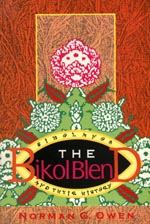-
This is a collection of ten essays and one address. All of the essays have previously appeared in print, the earliest in 1974 and the latest in 1990. The short address, entitled 'Bikolanos and their History' was presented to school teachers in the partido town of Tigaon in Camarines Sur during National History Week in 1983. It is published here for the first time.
-
The book has 291 pages, plus 14 pages of introductory material. The essays appear on 186 of these pages, while the remaining 105 pages are devoted to detailed notes (79 pages), a selected bibliography (2 pages), and an index (24 pages).
-
The book also includes three maps. The two maps appearing in the first essay and representing 'Geographic features' and the 'Partidos and major towns' are poorly reproduced and difficult to read. One of the two figures, based on map representations, could also be sharper. The three tables are clear and the text itself appears to be free of typographical errors.
-
Due to the historic nature of the essays, the nine year delay from the original publication of the latest essay in 1990 to the appearance of the current collection in 1999 matters little. A number of unfortunate incidents delayed publication of the collection since the original intention was to have it appear toward the beginning of the 1990s, rather than at the end.
-
The first of the essays, 'The Bikol Blend', which gives its name to the title of the collection, serves as an overview of the region and an introduction to the subjects touched on in the remaining nine essays. This introductory essay was not written for the collection and was originally published in 1978. It does however, encapsulate the interests of the author and his work both previous and subsequent to 1978 as represented in the essays.
-
The essays are arranged in chronological order by the period of Bikol history they treat, not by the order of original publication. This is most useful as it gives the reader some sense of progression, particularly as we look at the growth and subsequent contraction of the abaca industry through the eighteenth century and into the post Word War I period.
-
The second and third essays, respectively 'Problems in Partido, 1741-1810' and 'Requiem for a Heroic Priest', (this last only three pages long) are the only ones with an eighteenth century focus, and the final essay, 'Subsistence in the Slump: Adjustment in the Provincial Philippines' is the only essay with a full twentieth century focus, looking at the post Word War I economy of the Bikol region.
-
The ninth essay, 'Winding down the War in Albay: 1900-1903' is transitional, looking at the Philippine-American War and the change from Spanish to American administration in the Philippines at the turn of the century. The remaining five essays all examine the region in the eighteenth century.
-
These five essays include: A Subsistence Crisis in the provincial Philippines: 1845-1846'; 'Measuring Mortality in the Nineteenth Century Philippines'; 'Abaca in Kabikolan: Prosperity Without Progress', the longest of the essays and based on the author's Ph.D. research; 'Americans in the Abaca Trade: Peele, Hubbell and Co, 1856-1875'; and 'The Principalia in Philippine History: Kabikolan, 1790-1898'.
-
The notes, which comprise just over 25 per cent of the book, form what is a text parallel to the essays. These are well chosen, informative and interesting and well worth referring to as one reads through the essays.
-
The author uses a clear and uncluttered style of writing and is able to make even the drier, statistical aspects of his essays interesting. This, and the obvious quality of the research, may have been factors contributing to this collection winning the Best Book award in the Social Sciences category of the National Book awards for the year 2000 at the Philippine Book Fair.
-
For readers of Intersections who hope to find some mention of gender or the role of women in nineteenth century Bikol, the search will not be fruitful. For whatever reason, the nature of the resource material or the choice of the available material made by the author, women and gender issues hardly rate a mention in this collection of essays.

|

